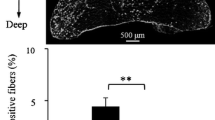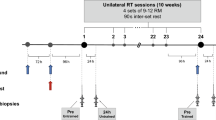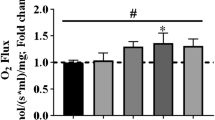Abstract
The aim of this study was to evaluate the effect of repeated bouts of exercise on the cytoskeletal proteins titin, desmin, and dystrophin. Rats were made to run downhill for 90 min 1 or 5 times separated by 14 days. Samples were taken from quadriceps femoris muscle 3, 48, 96 h and 50 days after the last exercise session and detected by quantitative PCR, histochemical stainings, and western blot analyses. Histopathological changes in titin, desmin, and dystophin stainings, an increase in β-glucuronidase activity (a quantitative indicator of muscle damage), a significant decrease in the relative content of dystrophin, and intramyocellular Evans blue staining (signs of changes in sarcolemmal permeability) observed after one exercise session were attenuated after 5 exercise sessions. Titin mRNA level was not increased after the initial exercise session but was increased after the fifth session. Desmin and dystrophin mRNA levels were increased after the first and fifth sessions with desmin showing a smaller increase after the fifth session compared to the first session. Prior exercise induces adaptation that protects the sarcolemma as well as subsarcolemmal, intermediate filament, and sarcomeric proteins against disruption. Changes in mRNA levels of titin, desmin, and dystophin after an acute exercise session obviously reflect the need of these proteins in the repair process following damage. After five sessions increase in mRNA of studied proteins suggest a strong involvement in continuing adaptation to the increased exercise.





Similar content being viewed by others

References
Barash IA, Peters D, Friden J, Lutz GJ, Lieber RL (2002) Desmin cytoskeletal modifications after a bout of eccentric exercise in the rat. Am J Physiol Regul Integr Comp Physiol 283:R958–R963
Barrett AJ (1972) Lysosomal enzymes. In: Dingle JT (ed) Lysosomes, a laboratory handbook. North-Holland Amsterdam, The Netherlands, pp 46–126
Biral D, Jakubiec-Puka A, Ciechomska I, Sandri M, Rossini K, Carraro U, Betto R (2000) Loss of dystrophin and some dystrophin-associated proteins with concomitant signs of apoptosis in rat leg muscle overworked in extension. Acta Neuropathol (Berl) 100:618–626
Carpenter S, Karpati G (1989) Segmental necrosis and its demarcation in experimental micropuncture injury of skeletal muscle fibers. J Neuropathol Exp Neurol 48:154–170
Clarkson PM, Tremblay I (1988) Exercise-induced muscle damage, repair, and adaptation in humans. J Appl Physiol 65:1–6
Crenshaw AG, Friden J, Hargens AR, Lang GH, Thornell LE (1993) Increased technetium uptake is not equivalent to muscle necrosis: scintigraphic, morphological and intramuscular pressure analyses of sore muscles after exercise. Acta Physiol Scand 148:187–198
Ebbeling CB, Clarkson PM (1989) Exercise-induced muscle damage and adaptation. Sports Med 7:207–234
Feasson L, Stockholm D, Freyssenet D, Richard I, Duguez S, Beckmann JS, Denis C (2002) Molecular adaptations of neuromuscular disease-associated proteins in response to eccentric exercise in human skeletal muscle. J Physiol 543:297–306
Fielding RA, Manfredi TJ, Ding W, Fiatarone MA, Evans WJ, Cannon JG (1993) Acute phase response in exercise III. Neutrophil and IL-1 beta accumulation in skeletal muscle. Am J Physiol 265:R166–R172
Friden J, Lieber RL (1998) Segmental muscle fiber lesions after repetitive eccentric contractions. Cell Tissue Res 293:165–171
Komulainen J, Vihko V (1998) The course of exercise-induced skeletal muscle fibre injury. In: Reznick AZ (ed) Oxidative stress in skeletal muscle. Birkhäuser Verlag Basel, Switzerland, pp 59–74
Komulainen J, Kytola J, Vihko V (1994) Running-induced muscle injury and myocellular enzyme release in rats. J Appl Physiol 77:2299–2304
Komulainen J, Takala TE, Kuipers H, Hesselink MK (1998) The disruption of myofibre structures in rat skeletal muscle after forced lengthening contractions. Pflugers Arch 436:735–741
Komulainen J, Kalliokoski R, Koskinen SO, Drost MR, Kuipers H, Hesselink MK (2000) Controlled lengthening or shortening contraction-induced damage is followed by fiber hypertrophy in rat skeletal muscle. Int J Sports Med 21:107–112
Lazarides E (1980) Intermediate filaments as mechanical integrators of cellular space. Nature 283:249–256
Lieber RL, Thornell LE, Friden J (1996) Muscle cytoskeletal disruption occurs within the first 15 min of cyclic eccentric contraction. J Appl Physiol 80:278–284
Lovering RM, De Deyne PG (2004) Contractile function, sarcolemma integrity, and the loss of dystrophin after skeletal muscle eccentric contraction-induced injury. Am J Physiol Cell Physiol 286:C230–C238
Lynch GS, Rafael JA, Chamberlain JS, Faulkner JA (2000) Contraction-induced injury to single permeabilized muscle fibers from mdx, transgenic mdx, and control mice. Am J Physiol Cell Physiol 279:C1290–C1294
Lynn R, Morgan DL (1994) Decline running produces more sarcomeres in rat vastus intermedius muscle fibers than does incline running. J Appl Physiol 77:1439–1444
Mair J, Mayr M, Muller E, Koller A, Haid C, Artner-Dworzak E, Calzolari C, Larue C, Puschendorf B (1995) Rapid adaptation to eccentric exercise-induced muscle damage. Int J Sports Med 16:352–356
McBride TA (2003) Stretch-activated ion channels and c-fos expression remain active after repeated eccentric bouts. J Appl Physiol 94:2296–2302
McHugh MP (2003) Recent advances in the understanding of the repeated bout effect: the protective effect against muscle damage from a single bout of eccentric exercise. Scand J Med Sci Sports 13:88–97
McHugh MP (2004) The role of exercising muscle length in the protective adaptation to a single bout of eccentric exercise. Eur J Appl Physiol 93:289–293
McHugh MP, Connolly DA, Eston RG, Gleim GW (1999) Exercise-induced muscle damage and potential mechanisms for the repeated bout effect. Sports Med 27:157–170
McNeil PL, Khakee R (1992) Disruptions of muscle fiber plasma membranes. Role in exercise-induced damage. Am J Pathol 140:1097–1109
Nosaka K, Clarkson PM (1995) Muscle damage following repeated bouts of high force eccentric exercise. Med Sci Sports Exerc 27:1263–1269
Otter T, King SM, Witman GB (1987) A two-step procedure for efficient electrotransfer of both high-molecular-weight (greater than 400,000) and low-molecular-weight (less than 20,000) proteins. Anal Biochem 162:370–377
Peters D, Barash IA, Burdi M, Yuan PS, Mathew L, Friden J, Lieber RL (2003) Asynchronous functional, cellular and transcriptional changes after a bout of eccentric exercise in the rat. J Physiol 553:947–957
Petrof BJ, Shrager JB, Stedman HH, Kelly AM, Sweeney HL (1993) Dystrophin protects the sarcolemma from stresses developed during muscle contraction. Proc Natl Acad Sci U S A 90:3710–3714
Rezvani M, Ornatsky OI, Connor MK, Eisenberg HA, Hood DA (1996) Dystrophin, vinculin, and aciculin in skeletal muscle subject to chronic use and disuse. Med Sci Sports Exerc 28:79–84
Salminen A (1985) Lysosomal changes in skeletal muscles during the repair of exercise injuries in muscle fibers. Acta Physiol Scand Suppl 539:1–31
Salminen A, Vihko V (1980) Acid proteolytic capacity in mouse cardiac and skeletal muscles after prolonged submaximal exercise. Pflugers Arch 389:17–20
Shah SB, Davis J, Weisleder N, Kostavassili I, McCulloch AD, Ralston E, Capetanaki Y, Lieber RL (2004) Structural and functional roles of desmin in mouse skeletal muscle during passive deformation. Biophys J 86:2993–3008
Spofford CM, Chilian WM (2003) Mechanotransduction via the elastin-laminin receptor (ELR) in resistance arteries. J Biomech 36:645–652
Straub V, Rafael JA, Chamberlain JS, Campbell KP (1997) Animal models for muscular dystrophy show different patterns of sarcolemmal disruption. J Cell Biol 139:375–385
Thompson HS, Clarkson PM, Scordilis SP (2002) The repeated bout effect and heat shock proteins: intramuscular HSP27 and HSP70 expression following two bouts of eccentric exercise in humans. Acta Physiol Scand 174:47–56
Trappe TA, Carrithers JA, White F, Lambert CP, Evans WJ, Dennis RA (2002) Titin and nebulin content in human skeletal muscle following eccentric resistance exercise. Muscle Nerve 25:289–292
Vihko V, Salminen A, Rantamaki J (1978) Acid hydrolase activity in red and white skeletal muscle of mice during a two-week period following exhausting exercise. Pflugers Arch 378:99–106
Wang K, Ramirez-Mitchell R (1983) A network of transverse and longitudinal intermediate filaments is associated with sarcomeres of adult vertebrate skeletal muscle. J Cell Biol 96:562–570
Willoughby DS, McFarlin B, Bois C (2003) Interleukin-6 expression after repeated bouts of eccentric exercise. Int J Sports Med 24:15–21
Yu JG, Furst DO, Thornell LE (2003) The mode of myofibril remodelling in human skeletal muscle affected by DOMS induced by eccentric contractions. Histochem Cell Biol 119:383–393
Acknowledgements
This study was supported by the LIKES Foundation and the Ministry of Education, Finland.
Author information
Authors and Affiliations
Corresponding author
Rights and permissions
About this article
Cite this article
Lehti, T.M., Kalliokoski, R. & Komulainen, J. Repeated bout effect on the cytoskeletal proteins titin, desmin, and dystrophin in rat skeletal muscle. J Muscle Res Cell Motil 28, 39–47 (2007). https://doi.org/10.1007/s10974-007-9102-0
Received:
Accepted:
Published:
Issue Date:
DOI: https://doi.org/10.1007/s10974-007-9102-0



